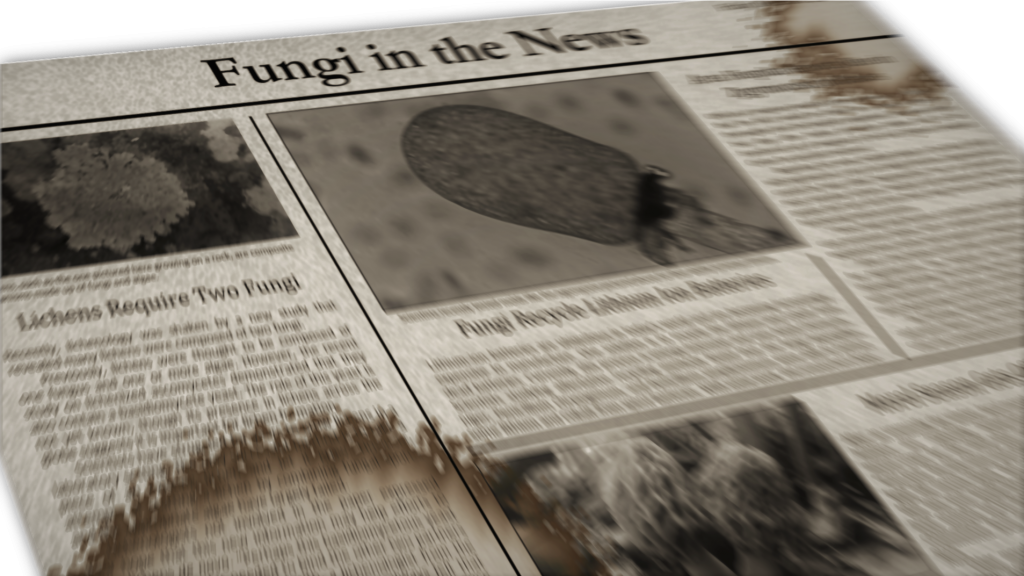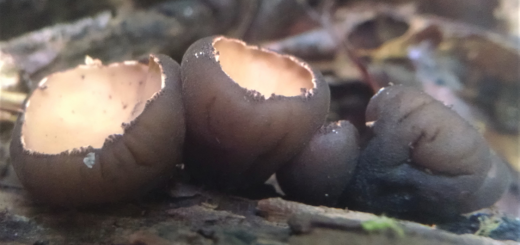2017 Spring News Update
Fungi appear in the news with surprising frequency. However, many of those stories do not provide any new information. Below is a summary of what we’ve learned about fungi from March through April 2017. Read below to learn about: C. auris in the U.S., aflatoxin-destroying corn, viruses defying fungal incompatibility, fungus-farming ant evolution, bat and salamander diseases, and more! Visit the associated links to get the full story.
With the growing concern over untrustworthy news sources and the media’s tendency to inaccurately report scientific studies, can these sources be trusted? Yes they can, with a bit of caution. I have checked to make sure all the articles based on scientific papers draw from peer-reviewed journals and that they accurately reflect the content of the papers. For articles not linked to scientific papers, I try to stick to sources with a good track record in reporting on science or to local sources for region-specific information. However, I encourage you to do your own research and decide for yourself whether these sources are trustworthy.
$15,000 for a Bit of Mold
An auction house in England recently sold a small dish containing an old clump of mold for $15,000. This may seem exorbitant for something you could easily acquire by leaving a slice of bread on the counter for too long. However, this particular mold is a Penicillium sp. that originally belonged to Alexander Fleming, a Nobel Prize winning scientist best known for his discovery of penicillin. Along with the dish of mold, the winning bidder received a collection of documents and other odds and ends that once belonged to Fleming. Read more at: https://www.cnet.com/news/penicillin-mold-auction-alexander-fleming/
C. auris Infections Reported from US Hospitals
Since the infectious fungus Candida auris was identified in the United States last year, 35 people in five states have been infected. New York State saw the most infections, although numbers in other states are expected to rise as the organism becomes established in hospitals. Thankfully, the strain in the United States has not yet developed robust antifungal resistance and is therefore treatable. This gives doctors hope that the pathogen can be contained. Read more at: https://www.washingtonpost.com/news/to-your-health/wp/2017/03/10/deadly-fungal-infection-that-doctors-have-been-fearing-now-reported-in-u-s/
GM Corn Uses RNA Bits to Destroy Fungal Toxins
In a new use of genetic engineering techniques, researchers developed a strain of corn that prevents fungi from producing toxins. Fungi in the genus Aspergillus regularly infect corn and produce the compound aflatoxin (FFF#202), which is known to cause liver cancer. Using a technique called “RNA interference,” the modified corn produces small bits of RNA that specifically target and block the fungus’ mRNA molecules that encode aflatoxin. The modified corn does not prevent fungal growth, but does make infected corn safe to eat. Since a small RNA molecule is the only novel compound produced by the modified corn, it should have little to no negative impacts on humans, although that will need to be confirmed before the corn can be grown for human consumption. If the modified corn is proven safe, it could help reduce cancer rates in countries that do not have the resources to test for aflatoxins. Read more at: http://www.newsweek.com/gmo-corn-cancer-571136
Bat Disease Reaches Texas
White-nose syndrome (WNS, FFF#026), a disease that has killed millions of bats across the eastern United States, has now been detected in Texas. Disease symptoms have not yet been observed, but DNA from Pseudogymnoascus destructans – the fungus that causes WNS – was detected on hibernating bats in six Texas counties. Researchers expect WNS to have a minimal impact on Texas bats; many bat species that live in Texas do not hibernate long enough for the disease to be lethal. However, those that survive WNS can become carriers and spread the fungal spores over long distances. For example, the Mexican free-tailed bat is not expected to die from WNS but will likely help spread the disease as far south as Honduras. Now that the fungus has arrived in Texas, it will likely spread west to Arizona and then to the rest of the continental United States. Read more at: https://www.washingtonpost.com/news/energy-environment/wp/2017/03/23/a-merciless-bat-killing-fungus-is-on-the-move-again-now-its-in-texas/
Virus Breaks Fungal Incompatibility
Researchers studying the fungal plant pathogen Sclerotinia sclerotiorum discovered a virus that reduces the fungus’ incompatibility reaction. When two fungi of the same species meet, a series of chemical interactions determines whether they can fuse with one another (see FFF#128). If the chemicals do not match up correctly, the cells at the contact point die and the fungi are “vegetatively incompatible.” A major benefit of being incompatible is that viruses cannot spread from one fungus to the next. However, the newly discovered Sclerotinia sclerotiorum mycoreovirus 4 (SsMYRV4) gets around this by turning down its host’s incompatibility reaction. This prevents cells that contact another fungus from dying and allows SsMYRV4 to infect strains that should be incompatible. In the past, scientists have tried to control the spread of fungal diseases using mycoviruses, but these attempts were not very successful because the viruses could not spread to incompatible strains. SsMYRV4 may help researchers find a way around this problem, potentially opening up exciting new possibilities for controlling the spread of fungal pathogens. Read more at: https://www.sciencedaily.com/releases/2017/03/170323141424.htm
Terrestrial Fungi May Invade Coral Reefs
A preliminary study on the microbial communities of coral reefs off the coast of Florida indicates that human activity may be introducing terrestrial bacteria and fungi into the aquatic ecosystems. DNA sequencing of samples taken from coral reefs near Florida revealed that the reefs contained bacteria and fungi normally found in coastal inlets and wastewater. Other studies of reefs that have mostly escaped the effects of human activity have not detected terrestrial microbes. Although not conclusive, this suggests that human activities along the coastline help introduce terrestrial organisms into coral reefs. This is bad news for coral reefs, which are already threatened by rising sea temperatures due to climate change. Novel land-dwelling organisms have the potential to disrupt reef ecosystems and exacerbate the problems reefs already face. Read more at: https://phys.org/news/2017-03-land-based-microbes-invading-coral-reefs.html
Evolution of Fungus-Farming Ants
Research from the Smithsonian Institution has helped shed light on the likely origins of ant agriculture. The new study sequenced DNA from 78 ant species that farm fungus and 41 that do not. Analysis of that data resulted in a phylogenetic tree that was then linked to known dates from the fossil record. This showed that the ants first developed complex farming systems around 30 million years ago, about the same time as the global climate shifted to a cooler phase and decreased the size of South American tropical rainforests. The study’s authors speculate that ants casually farming fungi adapted to their cooler and drier climate by bringing the fungus underground and carefully regulating its environment to mimic its normal rainforest habitat. Since the aboveground environment was no longer favorable to the fungus, it became separated from its species. This allowed the ants to domesticate the fungus over millions of years and eventually resulted in the complex farming mechanisms ants use today. Read more at: http://www.smithsonianmag.com/science-nature/how-ants-became-worlds-best-fungus-farmers-180962871/
Outlook Bleak for Europe’s Salamanders
Scientists in Europe fear that the fungal pathogen Batrachochytrium salamandrivorans (Bsal) – a close relative of the fungus decimating global frog populations – will wipe out all of Europe’s vulnerable salamander species. Many European salamanders have small ranges and are already threatened with extinction due to human activity. Given the virulence of Bsal, zoos and captive breeding programs will probably be the only way to protect vulnerable species. Read more at: http://www.bbc.com/news/science-environment-39642462









![#011: Characteristics of Kingdom Fungi [Archived]](https://www.fungusfactfriday.com/wp-content/themes/hueman/assets/front/img/thumb-small-empty.png)

1 Response
[…] to be seen whether or not these will be cost effective for use in developing countries. (See Spring and Fall 2017 News Updates for […]